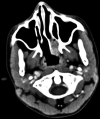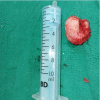Middle turbinate angiofibroma in an adolescent boy
- PMID: 35131785
- PMCID: PMC8823056
- DOI: 10.1136/bcr-2021-246490
Middle turbinate angiofibroma in an adolescent boy
Abstract
Bleeding nasal mass in adolescent boys has customarily been attributed to Juvenile nasopharyngeal angiofibroma. However, little is known regarding the extranasopharyngeal origin of angiofibroma, as highlighted in this case report of a 15-year-old boy who presented with recurrent epistaxis and nasal obstruction. On constructing a working diagnosis of nasal haemangioma, the patient was taken up for endoscopic excision under general anaesthesia. Intraoperative endoscopic findings and histopathological examination revealed the diagnosis of middle turbinate angiofibroma, which is an extremely rare extranasopharyngeal angiofibroma. Consequently, this represents the third described case of a juvenile angiofibroma arising from the middle turbinate.
Keywords: hemangioma; otolaryngology / ENT; pathology.
© BMJ Publishing Group Limited 2022. No commercial re-use. See rights and permissions. Published by BMJ.
Conflict of interest statement
Competing interests: None declared.
Figures




Similar articles
-
Middle turbinate angiofibroma in an elderly woman.Vojnosanit Pregl. 2009 Jul;66(7):583-6. doi: 10.2298/vsp0907583p. Vojnosanit Pregl. 2009. PMID: 19678585
-
Extranasopharyngeal angiofibroma of the nasal septum: a case report.Ear Nose Throat J. 2009 Nov;88(11):E17-9. Ear Nose Throat J. 2009. PMID: 19924651 Review.
-
Extranasopharyngeal angiofibroma.Int J Pediatr Otorhinolaryngol. 2000 Nov 30;56(1):59-64. doi: 10.1016/s0165-5876(00)00404-3. Int J Pediatr Otorhinolaryngol. 2000. PMID: 11074117 Review.
-
Inferior Turbinate Angiofibroma in a Middle-Aged Man.Ear Nose Throat J. 2019 Aug;98(7):407-408. doi: 10.1177/0145561319825741. Epub 2019 Feb 13. Ear Nose Throat J. 2019. PMID: 31405305 No abstract available.
-
Nasal Septal Angiofibroma.Ear Nose Throat J. 2023 Oct;102(10):NP483-NP484. doi: 10.1177/01455613211026517. Epub 2021 Jun 16. Ear Nose Throat J. 2023. PMID: 34134540
Cited by
-
Middle Turbinate Angiofibroma in a Middle-Aged Female: A Case Report and Review of the Literature.Indian J Otolaryngol Head Neck Surg. 2024 Oct;76(5):4657-4660. doi: 10.1007/s12070-024-04740-6. Epub 2024 May 27. Indian J Otolaryngol Head Neck Surg. 2024. PMID: 39376370
References
-
- Hwang HC, Mills SE, Patterson K, et al. . Expression of androgen receptors in nasopharyngeal angiofibroma: an immunohistochemical study of 24 cases. Mod Pathol 1998;11:1122–6. - PubMed
Publication types
MeSH terms
LinkOut - more resources
Full Text Sources
Medical
Research Materials
Miscellaneous
